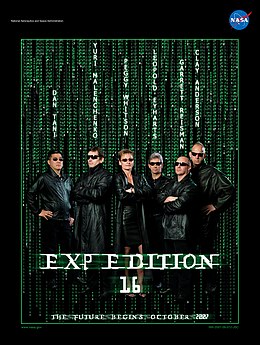
Back Expedició 16 Catalan Expedice 16 Czech ISS Ekspedition 16 Danish ISS-Expedition 16 German Expedition 16 Greek Expedición 16 Spanish 16. ekspeditsioon Estonian Retkikunta 16 Finnish Expédition 16 (ISS) French משלחת מס' 16 לתחנת החלל הבין-לאומית HE
 Promotional Poster | |
| Mission type | ISS Expedition |
|---|---|
| Mission duration | 192 days (launch to landing) |
| Expedition | |
| Space station | International Space Station |
| Began | 10 October 2007 |
| Ended | 19 April 2008, 10:30 UTC |
| Arrived aboard | Soyuz TMA-11 Anderson: STS-117 Space Shuttle Atlantis Tani: STS-120[1] Space Shuttle Discovery Eyharts: STS-122 Space Shuttle Atlantis Reisman: STS-123 Space Shuttle Endeavour |
| Departed aboard | Soyuz TMA-11 Anderson: STS-120[1] Space Shuttle Discovery Tani: STS-122 Space Shuttle Atlantis Eyharts: STS-123 Space Shuttle Endeavour Reisman: STS-124 Space Shuttle Discovery |
| Crew | |
| Crew size | 3 |
| Members | Peggy Whitson Yuri Malenchenko Clayton Anderson* (October) Daniel Tani (October–February) Léopold Eyharts (February–March) Garrett Reisman† (March–April) * - transferred from Expedition 15 † - transferred to Expedition 17 |
| EVAs | 5 |
| EVA duration | 35 hours, 21 minutes |
 Expedition 16 mission patch  The official Expedition 16 crew portrait. (left to right) Anderson, Malenchenko, Tani, Eyharts, Whitson, Reisman | |
Expedition 16 was the 16th expedition to the International Space Station (ISS). The first two crew members, Yuri Malenchenko and Peggy Whitson, launched on 10 October 2007, aboard Soyuz TMA-11, and were joined by spaceflight participant Sheikh Muszaphar Shukor, the first Malaysian in space.[2][3]
Expedition 15 Flight Engineer Clayton Anderson did not land with the Soyuz TMA-10, so he was considered part of Expedition 16 for the few weeks prior to the arrival of STS-120.[4] STS-120 launched on 23 October, docked on 25 October, and replaced Anderson with new Flight Engineer Daniel Tani.[1][5][6] Following docking, the Soyuz seat liners for Anderson and Tani were swapped, and Anderson became part of the STS-120 crew. Léopold Eyharts, who came aboard during STS-122, joined the mission on 9 February 2008, replacing Tani.[2][7] The crew was then joined by Garrett Reisman, who was launched aboard Endeavour with STS-123, on 11 March 2008, replacing Eyharts. Reisman joined Expedition 16 in progress, and was a part of Expedition 17 as well. Upon reentry, the astronaut's Soyuz TMA-11 spacecraft suffered a minor malfunction, causing the craft to follow a very steep ballistic descent. As a result, the crew experienced forces up to 10 G, ending up about 260 miles (418 km) west of the targeted landing site. Roscosmos reported all three crew members were doing just fine and in good health.[8]
- ^ a b c NASA (2007). "STS-120". National Aeronautics and Space Administration. Retrieved 9 October 2007.
- ^ a b NASA (2007). "NASA Announces Three International Space Station Crews". NASA. Archived from the original on 26 May 2012. Retrieved 9 October 2007.
- ^ SpaceDaily (2007). "Expedition 16 Crew To Launch From Baikonur". Space Travel Exploration and Tourism - SpaceDaily. Retrieved 9 October 2007.
- ^ Tariq Malik (2007). "Space Station Astronauts Prepare for Crew Swap". Space.com. Retrieved 9 October 2007.
- ^ William Harwood (2007). "Discovery docks with space station". CBS News. Retrieved 25 October 2007.
- ^ UPI (2007). "Discovery successfully docks at the ISS". United Press International. Retrieved 25 October 2007.
- ^ Spacefacts (2007). "Expedition 16". Spacefacts. Retrieved 9 October 2007.
- ^ "Soyuz crew endures severe G-forces on re-entry - CNN.com". CNN. 19 April 2008. Retrieved 2 May 2010.